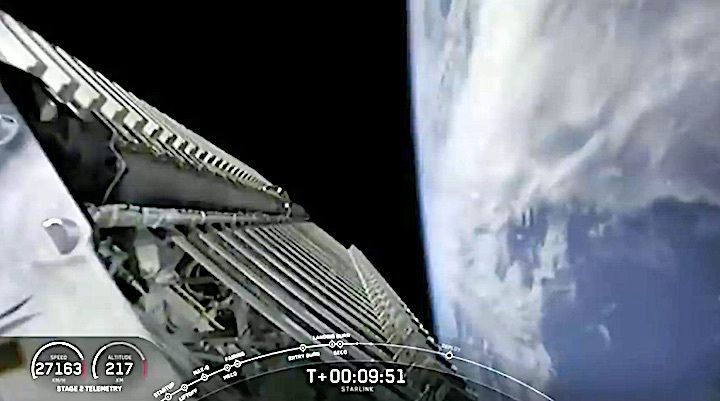24.07.2024
Starlink satellites now maneuver 275 times per day to avoid space objects.

Satellites in SpaceX's Starlink megaconstellation made nearly 50,000 collision-avoidance maneuvers in the last six months, about double the number made in the previous half-year.
Although experts praise Elon Musk's space compay for its commitment to transparency, they warn about the implications of the soaring orbital traffic.
SpaceX revealed the increase in its latest Semiannual Constellation Status Report, which was filed with the U.S. Federal Communications Commission (FCC) on July 1. According to the report, on average, each Starlink satellite fired its thrusters 14 times between Dec. 1, 2023, and May 31, 2024, to dodge orbiting objects, such as other Starlink satellites, spacecraft owned by other operators and pieces of space debris. Within that same six-month period, the Starlink constellation grew from around 5,100 operational satellites to 6,200 spacecraft.
SpaceX also said it decreased the threshold for maneuvering by a further degree of magnitude, which means its satellites now move to avoid a potential collision when chances of a smashup are just one in a million. That threshold, SpaceX said in the report, is 100 times lower than the industry standard.
SpaceX began deploying the Starlink constellation in May 2019 and within a few months became the world's largest satellite operator. The megaconstellation quickly became a source of concern for space sustainability experts as it drove orbital traffic into an entirely new era — one in which performing collision-avoidance maneuvers is a daily necessity rather than an occasional inconvenience. During the first four years after the first Starlink launch, the number of evasive maneuvers kept doubling every six months, reaching 25,299 in the half-year leading up to May 31, 2023. Between May and December 2023, the number of maneuvers remained the same despite the increase in the number of satellites.
Hugh Lewis, a professor of astronautics at the University of Southampton in the U.K. and Europe's leading space sustainability expert, told Space.com that the recent doubling must be mostly due to the decreased maneuvering threshold now used by SpaceX.
"Starlink satellites would have made approximately 25,000 maneuvers in the period from December 1, 2023, through May 31, 2024, if the threshold remained the same," Lewis said. "This is about the same as in the previous two semi-annual reports, despite the increasing number of satellites in the constellation."
Lewis, who has been monitoring the effects of megaconstellations on orbital safety for years, said he would have expected a higher number of maneuvers, considering the constellation's growing size.
"I would have expected that increasing the size of the constellation would have led to a higher number of maneuvers, but I suspect that the increasing solar activity is also causing a reduction in the debris population around the Starlink altitude," said Lewis. "These two competing effects seem to be resulting in the apparent stabilization of the number of maneuvers."
Space weather around Earth, caused by coronal mass ejections and other solar eruptions, thickens the tenuous gas in the planet's upper atmosphere where satellites orbit. As a result, the spacecraft there experience higher drag, which pulls them to lower altitudes. The powerful solar storm that hit Earth in May this year, triggering spectacular aurora displays all over the world, for example, reduced altitudes of satellites in low Earth orbit by nearly half a mile, according to a recent study. Dead satellites and other pieces of space debris may have sunk by several kilometers during the four-day event, the study estimated, which would lead to their speedier reentry into Earth's atmosphere.
Starlink satellites make their decisions to dodge other objects autonomously using onboard AI. While the growing number of maneuvers is designed to make orbital operations safe, it can also have negative effects on predictions of future collisions. A study by the Pennsylvania-based Commercial Space Operations Center (COMSPOC), published last year, found that every collision-avoidance maneuver throws off satellite path forecasts for several days. In the aftermath of maneuvers, satellites' actual positions may differ from their forecasted ones by up to 25 miles (40 kilometers), making collision predictions inaccurate.
Lewis added that the more maneuvers Starlink satellites make, the faster they use up their propellant, resulting in a shortening of their operational lives. SpaceX is committed to a zero-debris policy where Starlink is concerned and therefore deorbits the satellites at the end of their lives. In the six-month period covered by the latest report, only one satellite failed to deorbit.
SpaceX continues to build out the Starlink megaconstellation, which could eventually feature up to 42,000 satellites. According to Lewis' prediction, the number of Starlink avoidance maneuvers will continue to rise over the next few years as well, reaching 80,000 per half-year by 2027.
Quelle: SC
